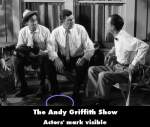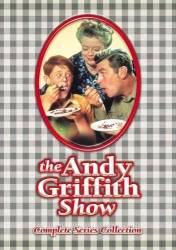
Visible crew/equipment: While Aunt Bee, Andy, Barney, and Gomer are on the porch talking about the band, just as Andy says, "We're talking about gettin' up a band concert by tonight," the chalk T-mark is visible on the floor by Andy's feet. (00:12:25)
Visible crew/equipment: Barney shows up with the concert sign while Andy's sawing wood, and when he and Andy talk about it, the shadow of the boom pole/mic is moving around on the ground, at the lower left corner of the screen. More of the boom's shadow is visible again, when Gomer shows up and they talk about Goober. (00:14:30)
Visible crew/equipment: At the end, when Dr. Breen tells the very tired group, "You all look as serene and relaxed as if you'd just finished listening to a pleasant band concert," in the next shot facing the porch, the shadow of the boom mic is moving around between the two windows above Clara and Andy, at the top of the screen.






Answer: In S3 x E11 Convicts-at-Large, there is a character named Big Maude Tyler, who is the leader of three female escaped convicts. Andy listens to the radio as the news announcer says that Big Maude's aliases include Clarice or Annabelle Tyler and also one amusingly named Ralph Henderson.
Super Grover ★